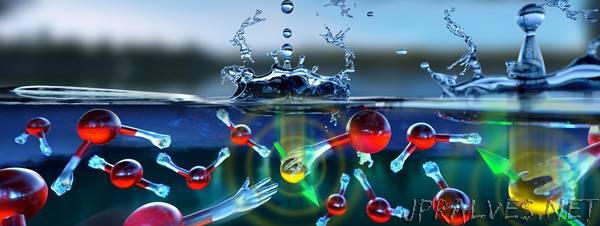
“It’s a popular tradition to throw coins into fountains in the hopes of having wishes granted. But what would happen if you could “throw” electrons into the water instead? That is, what happens shortly after an electron is injected into water?
This decades-old question now has an answer, thanks to an article published in Nature Communications on January 16. The study is the result of collaboration among researchers at the University of Chicago, the U.S. Department of Energy’s (DOE) Argonne and Lawrence Livermore National Laboratories, and the University of California — San Diego.
“Knowing the electron affinity of liquid water is crucial to understanding and modeling processes involving electron transfer between solids and the liquid, … ” — Alex Gaiduk, postdoctoral fellow at the University of Chicago.
Until now, scientists faced technical challenges when they wanted to experimentally measure the electron affinity of water, said Professor Giulia Galli, Liew Family Professor at the Institute for Molecular Engineering at the University of Chicago and senior scientist at Argonne.
“Most of the results quoted in the literature as experimental numbers are actually values obtained by combining some measured quantities with crude theoretical estimates,” she said.
Accurate theoretical measurements, on the other hand, have been out of reach for some time due to the difficulty and high computational cost of simulating the interactions directly, said University of California-San Diego professor Francesco Paesani, a co-author of the study who has spent years developing an accurate potential for the modeling of liquid water.
The interaction potential between water molecules developed by Paesani was used to model the structure of both liquid water and the water’s surface. Once the structure was obtained, highly accurate theoretical methods and software to study excited states of matter, developed by Galli’s team, were used to understand what happens when an electron is injected into water.
Fundamentally, the researchers sought to understand whether the electron resides in the liquid and eventually participates in chemical reactions. The central question was, “Does the liquid bond with the electron right away?”
The researchers found that the electron binds with the water; however, its binding energy is much smaller than previously thought. This prompted the researchers to revisit a number of well-accepted data and models for the electron affinity of water.
Galli and her co-workers developed the methods for excited states used in this study over the years, in collaborations with T. A. Pham, from Lawrence Livermore, and Marco Govoni, from Argonne, both of whom are co-authors of this study.
“Using the software developed to study excited state phenomena in realistic systems (named Without Empty STates, or WEST) and the Argonne Leadership Computing Facility (ALCF), we were finally able to generate data for samples both large enough and on sufficiently long timescales to study the electron affinity of liquid water,” Govoni said.
“We found large differences between the affinity at the surface and in the bulk liquid. We also found values that were different from those accepted in the literature, which prompted us to revisit the full energy diagram of an electron in water,” Pham added.
This finding has important consequences, both for scientists who seek to fundamentally understand the properties of water and for those who want to describe reduction/oxidation reactions in aqueous solutions, which are widespread in chemistry and biology.
In particular, scientists often use information about the energy levels of water when they screen materials for photo-electrochemical cells. A reliable estimate of the water electron affinity (which the researchers of the study provided for both bulk water and its surface) will help scientists establish computational protocols that are more robust and more reliable, and improve computational screening of materials.
Funding for the work by Gaiduk and co-workers was provided by the DOE Office of Science through the Midwest Integrated Center for Computational Materials. Additional support was provided by the Natural Sciences and Engineering Research Council of Canada, the National Science Foundation and the Lawrence Fellowship. The researchers used the ALCF, a DOE Office of Science User Facility, for the study. Computer time was provided by the Innovative and Novel Computational Impact on Theory and Experiment (INCITE), Extreme Science and Engineering Discovery Environment (XSEDE) and Lawrence Livermore National Laboratory Grand Challenge programs.”
